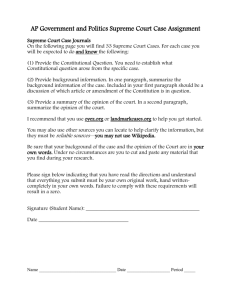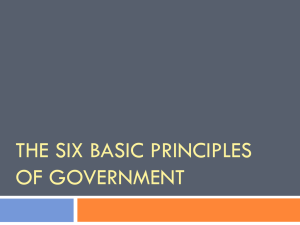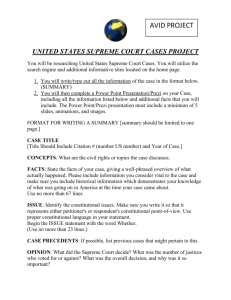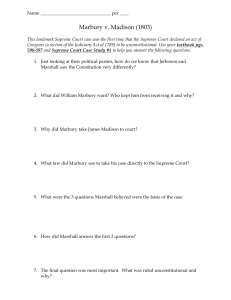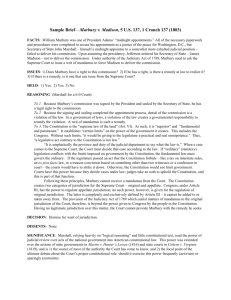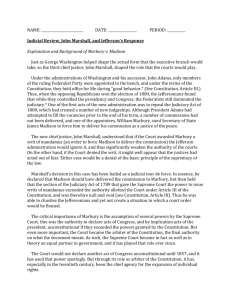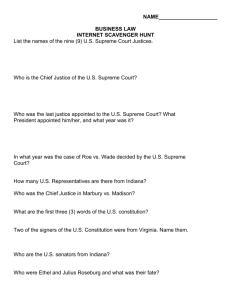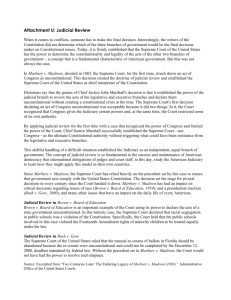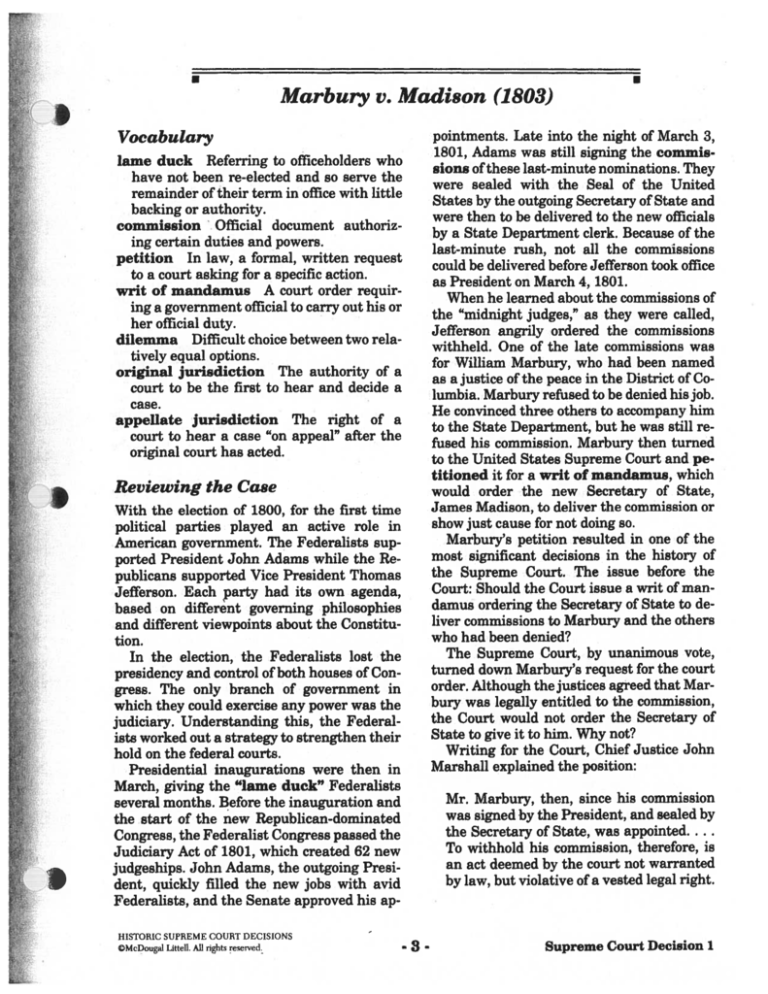
I
Marbury v. Madison (1803)
pointments. Late into the night of March 3,
1801, Adams was still signing the commis
sions of these last-minute nominations. They
were sealed with the Seal of the United
States by the outgoing Secretary of State and
were then to be delivered to the new officials
by a State Department clerk. Because of the
last-minute rush, not all the commissions
could be delivered before Jefferson took office
as President on March 4, 1801.
When he learned about the commissions of
the “midnight judges,” as they were called,
Jefferson angrily ordered the commissions
withheld. One of the late commissionE was
for William Marbury, who had been named
as a justice of the peace in the District of Co
lumbia. Marbury refused to be denied his job.
He convinced three others to accompany him
to the State Department, but he was still re
fused his commission. Marbury then turned
to the United States Supreme Court and pe
titioned it for a writ of mandamus, which
would order the new Secretary of State,
James Madison, to deliver the commission or
show just cause for not doing so.
Marbury’s petition resulted in one of the
most significant decisions in the history of
the Supreme Court. The issue before the
Court: Should the Court issue a writ of man
damus ordering the Secretary of State to de
liver commissions to Marbury and the others
who had been denied?
The Supreme Court, by unanimous vote,
turned down Marbury’s request for the court
order. Although the justices agreed that Marbury was legally entitled to the commission,
the Court would not order the Secretary of
State to give it to him. Why not?
Writing for the Court, Chief Justice John
Marshall explained the position:
Vocabulary
lame duck Referring to officeholders who
have not been re-elected and so serve the
remainder of their term in office with little
backing or authority.
commission Official document authoriz
ing certain duties and powers.
petition In law, a formal, written request
to a court asking for a specific action.
writ of mandamus A court order requir
ing a government official to carry out his or
her official duty.
dilemma Difficult choice between two rela
tively equal options.
original jurisdiction The authority of a
court to be the first to hear and decide a
case.
appellate jurisdiction The right of a
court to hear a case “on appeal” after the
original court has acted.
Reviewing the Case
With the election of 1800, for the first time
political parties played an active role in
American government. The Federalists sup
ported President John Adams while the Re
publicans supported Vice President Thomas
Jefferson. Each party had its own agenda,
based on different governing philosophies
and different viewpoints about the Constitu
tion.
In the election, the Federalists lost the
presidency and control of both houses of Con
gress. The only branch of government in
which they could exercise any power was the
judiciary. Understanding this, the Federal
ists worked out a strategy to strengthen their
hold on the federal courts.
Presidential inaugurations were then in
March, giving the “lame duck” Federalists
several months. Before the inauguration and
the start of the new Republican-dominated
Congress, the Federalist Congress passed the
Judiciary Act of 1801, which created 62 new
judgeships. John Adams, the outgoing Presi
dent, quickly filled the new jobs with avid
Federalists, and the Senate approved his ap
HISTORIC SUPREME COURT DECISIONS
©McDougal Littell. All rights reserved.
Mr. Marbury, then, since his commission
was signed by the President, and sealed by
the Secretary of State, was appointed..
To withhold his commission, therefore, is
an act deemed by the court not warranted
by law, but violative of a vested legal right.
-3-
Supreme Court Decision 1
The question was not Marbury’s right to
have the job, but the Court’s own constitu
tional authority. The case had created a di
lemma for the Court.
On the one hand, if the Court ruled in favor
of Marbury and issued the writ, the new ad
ministration under Jefferson most likely
would ignore it. That would make the Su
preme Court look weak, emphasizing the fact
that the Court had no way to enforce its deci
sioñs. For that, it had to rely on the executive
branch—the people to whom the order
applied.
On the other hand, deciding not to issue
the writ also would make the Court look
weak. It would appear as if.the Court were
avoiding its duty by giving in to the executive
branch.
How could the Court disentangle itself
from such a treacherous decision? Marshall
turned to the Constitution itself to point out
that it did not give the Court original juris
diction in a case like this:
with the question of what to do about an act
of Congress that violated the Constitution.
His explanation established an important
principle:
there is no middle ground. The Consti
tution is either-a superior paramount law,
unchangeable by ordinary means, or it is
on a level with ordinary legislative acts,
and, like other acts, is alterable when the
legislature shall please to alter it. If the
former part. . be true, then a legislative
act contrary to the Constitution is not law:
if the latter part be true, then written con
stitutions are absurd attempts, on the part
of people, to limit a power in its nature il
limitable..
It is emphatically the province and duty
of the judicial department to say what the
law is.. So if a law be in opposition to the
Constitution; if both the law and the Con
stitution apply to a particular case
the
court must determine which of these con
flicting rules governs the case. This is the
very essence ofjudicial duty.
Thus the particular phraseology [word
ing] of the Constitution of the United
States confirms and strengthens the prin
ciple, supposed to be essential to all writ
ten constitutions, that a law repugnant to
the Constitution is void..
•
.
.
.
..
.
.
.
.
The Constitution vests the whole judicial
power of the United States in one Supreme
Court, and such inferior courts as Congress
shall from time to time, ordain and estab
lish.
In the distribution of this power it
is declared that “the Supreme Court shall
have original jurisdiction in all cases af
fecting ambassadors, other public minis
ters and consuls, and those in which a state
shall be a party. In all other cases, the Su
preme Court shall have appellate juris
diction.”. To enable the Court, then, to
issue a mandamus, it must be shown to be
an exercise of appellate jurisdiction.
.
.
.
The long-term significance of this case was
Marshall’s use of the Constitution to give the
Supreme Court the power of judicial review,
even though that was not the original issue.
While the justices agreed that Marbury was
entitled to his court order, the act of Congress
that would allow them to issue it went beyond
the Constitution. It was the first time the
Court openly declared an act of Congress un
constitutional and claimed the right to be the
final authority on the meaning of the U.S.
Constitution. Judicial review was not used
again by the Court in regard to Congress for
another 54 years, but in the twentieth centu
ry it became a powerful tool for influencing
public policy.
.
Since Marbury’s case had not come from a
lower court, the Supreme Court could not act,
Marshall said. In addition, its power to issue
such writs to public officers came from an Act
of Congress, not the Constitution. In struc
turing the federal courts, Congress had
passed the Judiciary Act of 1789, which gave
the Supreme Court expanded original powers
beyond the Constitution. In following this
line of reasoning, Marshall then was faced
I
HISTORIC SUPREME COURT DECISIONS
)McDouga1 LIReII. AU rights reserved.
I
—
—
Supreme Court Decision 1
I
__________
__________
Date
Name
)
Marbury v. Madison (1803)
Elements of the Case
Directions: Fill in the appropriate information for each of the follow
ing elements of this case.
1. State the issue before the Supreme Court in this case.
2. What facts of the case were presented to the Court?
le behind it?
3. What was the decision of the Court? What was the rationa
4. What was the effect of the decision?
IC,
HISTORIC SUPREME COURT DFCISIONS
©McDougal I ittell All rights reserved
—
5
—
Supreme Court Decision 1
Name
Marbury v. Madison (cont.)
Evaluation of the Case
Directions:
Use your own judgment to evaluate the justices’ decision
and state your opinion of that decision.
1. Do you think the framers of the Constitution intended the Supreme
Court to have the power of judicial review as part of the system of
“checks and balances”? Explain.
2. What would be the effect on the United States if this decision had not
validated the idea that the Supreme Court has the power to judge
whether acts of Congress are unconstitutional?
3.
According to Justice Marshall, what actions were necessary to make
the commissions legal? Was it the delivery of the commissions or was
it the process of Senate approval, the President’s signature, and the
official seal by the Secretary of State? Why was this an important
point?
HISTORIC SUPREME COURT DECISIONS
©McDougal Littell. All rights reserved.
-
6
-
Supreme Court Decision 1

